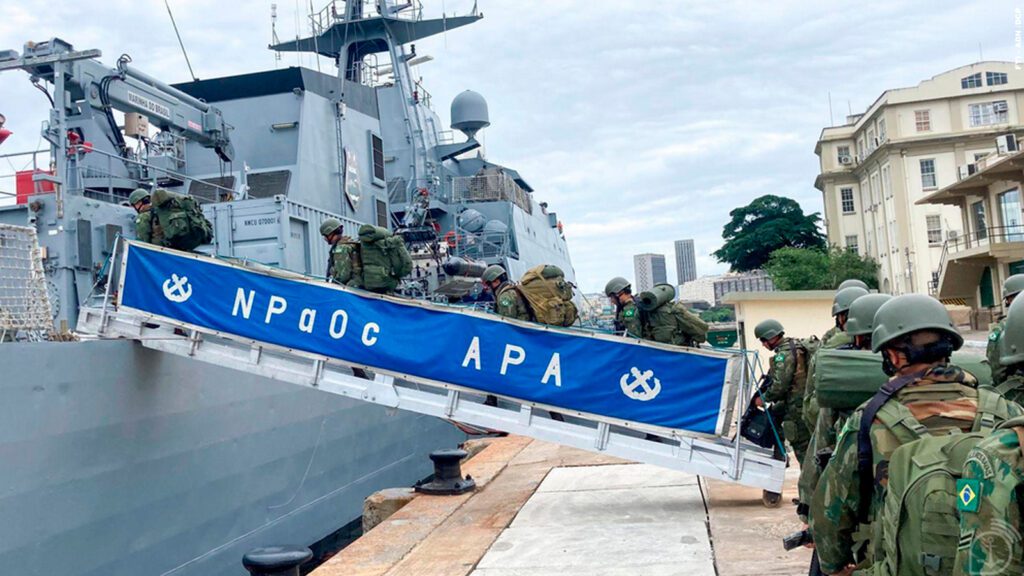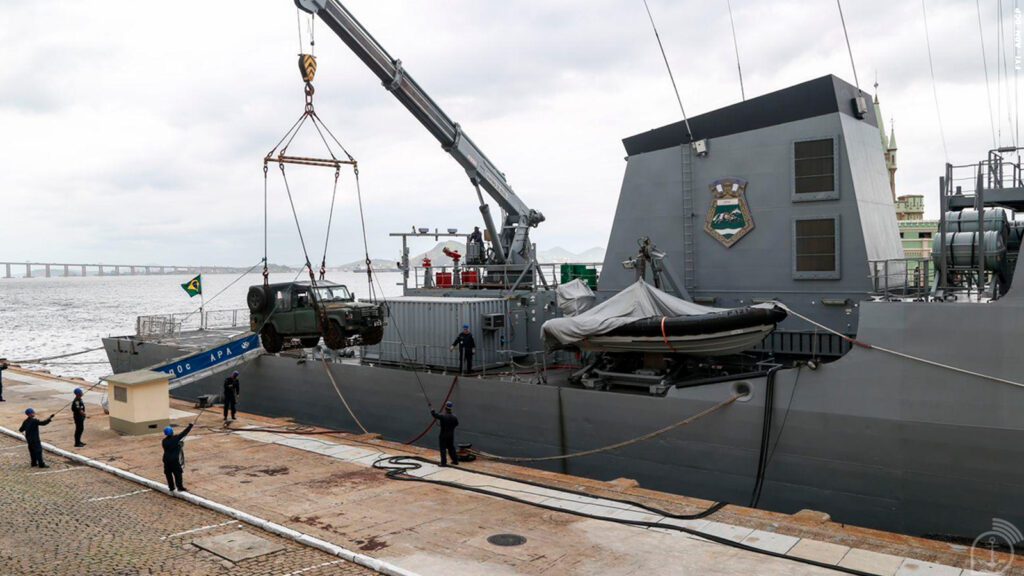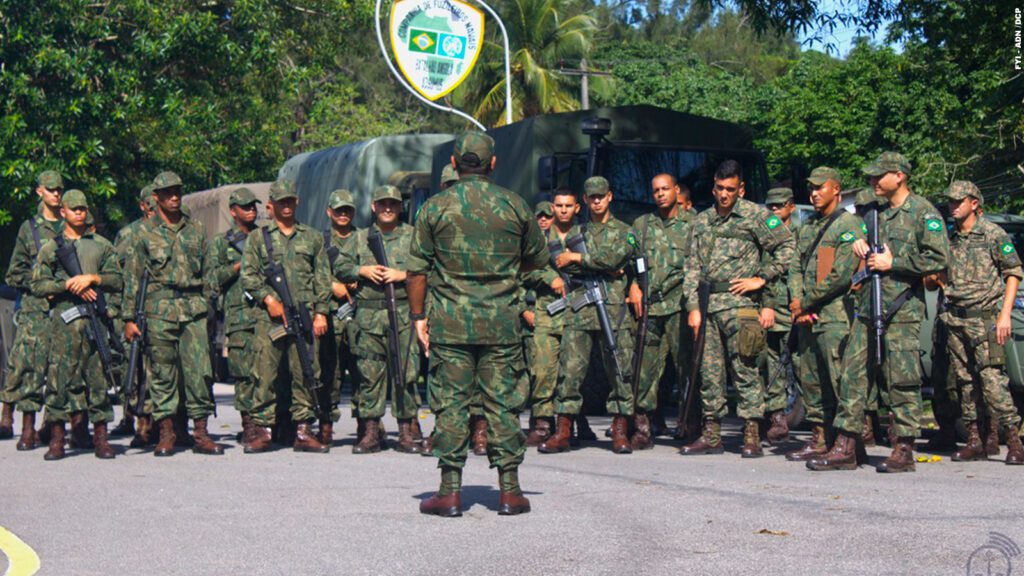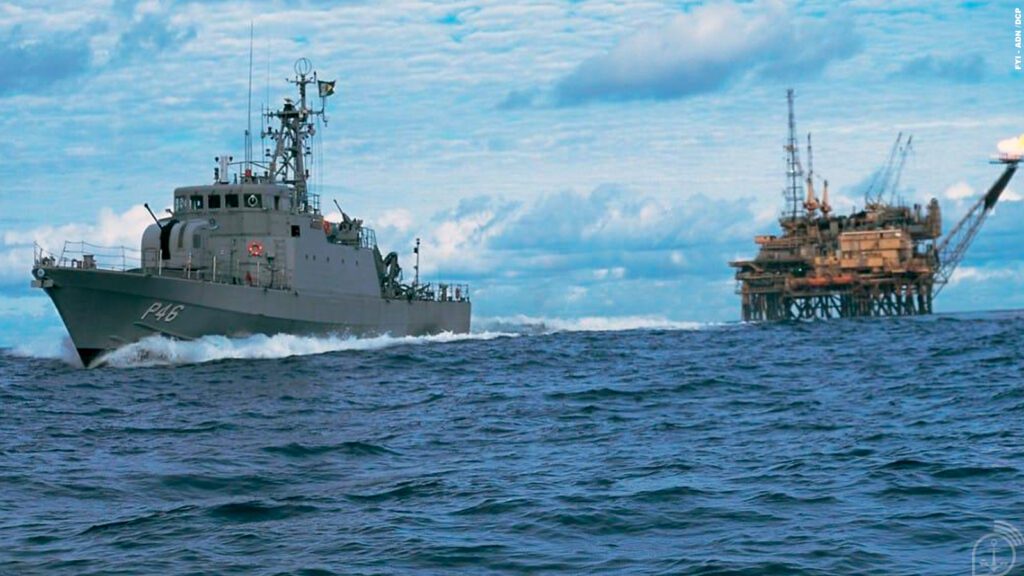Brazilian Navy deploys troops to ports in RJ and SP
By First Lieutenant (T) Taise Oliveira – Rio de Janeiro, RJ
Starting next Monday, the Brazilian Navy (MB) will be working in the ports of Itaguaí (RJ), Rio de Janeiro (RJ) and Santos (SP) to combat drug and arms trafficking, as well as other crimes. The measure is part of the Operation to Guarantee Law and Order (GLO) and will run until May 3, 2024.
Based on Decree 11.765, of November 1, signed by the President of the Republic, Luiz Inácio Lula da Silva, the military of the Armed Forces will carry out preventive and repressive actions at borders, ports and airports, in conjunction with Public Security bodies. The GLO grants the military police power to act in these areas.
1,900 MB military personnel will be deployed in the areas. The force will also use 120 assets, including patrol ships, boats, Amphibious Caterpillar Trucks, Piranha Armored Vehicles and Light Armored Wheeled Vehicles (JLTV), among others.
Operations in ports are already part of the MB’s scope of daily actions, but with naval inspections, which are administrative in nature. Under the GLO Decree, the Naval Force will be able to deploy troops, as explained by the Commander of the Navy, Admiral Marcos Sampaio Olsen. “When it comes to ports, the complementary law limits our role to logistical support, intelligence, communication and instruction. So, for troops to be deployed in these areas, a GLO decree is needed,” he explained.

Navy actions
Because they are crucial infrastructure for the national economic context, the country’s ports, especially those located in Itaguaí, Rio de Janeiro and Santos, have interconnected characteristics that enable the flow of goods, which attracts criminal organizations specialized in conducting international drug and arms trafficking.
The structure of these ports will rely on the support of 1,100 Marines (FN) in actions such as searching personnel and cracking down on crime. On Saturday (4), Marines and vehicles boarded the Ocean Patrol Vessel “Apa” bound for the Port of Santos.
The MB will also carry out actions in Guanabara Bay (RJ), Sepetiba Bay (RJ) and the maritime accesses to the Port of Santos (SP), reinforcing patrols and naval inspections in the adjacent maritime areas, in conjunction with public security agencies such as the Federal Police. The military personnel will work on board. Sniffer dogs will also be used.
Called “Lais de Guia”, the MB operation refers to one of the best known and most used knots, because it is so useful and reliable. The name symbolizes unity, representing the articulation and joint work that will be carried out between the Armed Forces and other public security agencies.
According to the Commander of the Operations Area, Vice Admiral (FN) Renato Rangel Ferreira, this operation is different from others that have been carried out before. “This Law and Order Operation has two aspects that differentiate it from previous ones. The first is what we can call a GLO of the Sea, it takes place with an emphasis on the sea and ports, unlike all the others that have taken place. The second is its strong interagency nature, as it only takes place with the cooperation and participation of the Federal Police, the Federal Highway Police, the Federal Revenue Service and the other bodies involved in controlling ports and inland waters,” he explained.

Understand what GLO is
The Guarantee of Law and Order operation is carried out exclusively by order of the President of the Republic, in an established area and for a fixed period of time. It is provided for in Article 142 of the Federal Constitution, in cases where the traditional public security forces, such as the state Military Police and Civil Police, have been exhausted in serious situations of disturbed order. It is usually decreed when state governments ask for federal help.
The GLO grants the military of the Armed Forces the attribution of police power until normality is restored, seeking to preserve public order, the integrity of the population and the regular functioning of institutions.
The Armed Forces have been involved in GLO operations since the 90s. The first took place in June 1992, in Rio de Janeiro, during the United Nations Conference on Environment and Development, ECO-92, with the aim of contributing to public security.
This type of operation was also used at the United Nations Conference on Sustainable Development (Rio + 20), in 2012; at the Confederations Cup and Pope Francis’ visit to Aparecida (SP), in 2013; at the World Cup, in 2014; and at the Olympic Games, in 2016.
In Rio de Janeiro, the last operation was carried out between 2017 and 2018, in conjunction with the Federal Intervention. Faced with a situation of insecurity, the actions were aimed at reducing crime and strengthening public security institutions in the state of Rio de Janeiro.

Resources used:
– Ocean Patrol Vessel “Apa”
– “Maracanã” Patrol Ship
– “Guajará” Patrol Ship
– “Guaporé” Patrol Ship
– Patrol Notice “Barracuda”
– Ocean Patrol Vessel “Amazonas”
– Ocean Support Vessel “Purus”
– “Macaé” Patrol Ship
– “Gurupi” Patrol Ship
– “Gurupá” Patrol Ship
– “Marlim” Patrol Notice
– “Anequim” Patrol Notice
– Patrol Notice “Abalcora”
– Armored Naval Inspection Boat “Cação”
– Armored Naval Inspection Boat “Mangangá”
– Teaching and Patrol Support Boat – LAEP 10
– Teaching and Patrol Support Vessels – LAEP 7
– Extra-Large Semi-Rigid Hull Vessel
– Large Semi-Rigid Hull Vessel
– Medium Semi-Rigid Hull Vessel
– Small Semi-Rigid Hull Vessels
– Watercraft
– Amphibious Caterpillar Command Car 19 Ton
– Amphibious Caterpillar Car for Personnel Transportation 18 Ton
– 18 Ton Armored Personnel Carrier (PIRANHA III C)
– Light Tactical Vehicles – JLTV 4×4
– Non-Specialized Transport Vehicles 5 Ton ATEGO
– Unspecialized Transport Vehicles UNIMOG U5000
– Specialized Transport Vehicle 5 Ton Cist “C” (Tanker type fuel tank trailer)
– Specialized Transport Vehicles 5 Ton Cist “A” (Water tanker trailer)
– Rescue VehicleSpecialized Transport Vehicle 5 Ton with Munck
– UTI Ambulances
– Administrative vehicle with open body
– Non-Specialized Transport Vehicles 3/4 Ton 4×4 L200
– Pick-Ups
– Plank Truck Forklift Crane 30T and 10T
– Administrative Vehicles


Source: Agência Marinha de Notícias *** Translated by DEFCONPress FYI Team ***
